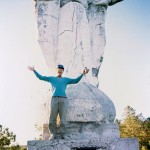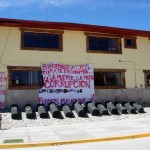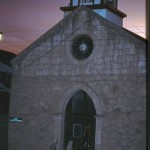Author’s note: The events herein recounted occurred almost 25 years ago. Without a doubt, most circumstances have changed.
Second author’s note: Be forewarned … there’s one part of this story that gets a bit unsavory.
Butch Cassidy: Jeesh, all Bolivia can’t look like this.
Sundance Kid: How do you know? This might be the garden spot of the whole country. People may travel hundreds of miles just to get to this spot where we’re standing now. This might be the Atlantic City, New Jersey, of all Bolivia for all you know.
— “Butch Cassidy and the Sundance Kid”
It was a law-of-diminishing-transportation-returns kind of sweltering Third-World overland journey that began well before dawn in Santo Domingo on a jam-packed, barnyard-fowl-dense, 1960s-era, shock-absorber-free school bus designed to accommodate legs no longer than those borne by pygmy kindergartners, then degenerated in Barahona to the back of a jam-packed shock-absorber-free dump truck that had obviously been used since 1945 to transport road kill, fish guts and a wide array of excrement to a fertilizer factory, then further still in Neiba, where we hired what in the Dominican Republic is called a guagua — small, antiquated Datsun or Toyota pick-up trucks in such states of dismal rusted-out, multi-colored, worn/mismatched-tired, dented, smoke-spewing disrepair that, had the orcs invented the internal-combustion engine, this is what they would have come up with — for the final 20-mile, two-plus-hour push along single-lane, shoulder-free, sinewy, unpaved mountain/jungle “roads” that managed to be simultaneously dusty, muddy, rutted, potholed, wash-boardy and populated by other guaguas being driven by people who seemed to be at least as drunk as the guy driving our guagua was, to our final destination: the diminutive and remote village of La Descubierta. Had it required one more transportation degeneration/transfer to reach La Descubierta (translated: “The Discovery”), we surely would have arrived riding piggyback on the handlebars of a flat-tired bicycle being pedaled by an arthritic octogenarian.
In other words: Very cool journey.
Still, by the time we were deposited in front of the humble headquarters for Isla Cabritos National Park, we were so beat-up and shell-shocked from the trip that we could scarcely stand straight. We were further disoriented and negatively physically impacted by the fact that this marked the first time we had been even remotely sober for several days, a situation I need to stress right here was in no way our fault. It was God’s fault — as I’m sure you will agree in a few moments — and what God lays before the likes of Norb and I, we are generally inclined to accept, no questions asked, unless, of course, those questions are both irrelevant and inane.
Norb, the expedition photographer, and I were, believe it or not, official guests of the Dominican National Tourism Office, a governmental entity that, because we were on assignment from Backpacker and Adventure Travel magazines to pen a few pieces on the outdoor recreation opportunities found in the DR, had given us a couple of free tickets on Dominicana Airlines. Everything was going remarkably smoothly until we boarded the not-exactly state-of-the-art plane in Miami. Most times, when jets with a capacity of several hundred passengers are “overbooked,” it is purely an administrative term — more tickets are sold then there are actual seats and, therefore, “X” number of would-be passengers are told, sorry, tough luck, but you’ll have to wait for the next plane out. This was not the case with our flight, which was overbooked by at least 70 people. But, rather than bumping those hapless folks, they were herded into the aisles, where they stood stoically as the doors were closed and the departure procedures initiated. Just as we were about to pull back from the gate, the doors were suddenly re-opened with a startling degree of exigency and everyone on the plane was ordered to disembark post haste. Surely, thought Norb and I, the FAA had got wind of the overbooking situation and had stepped in to rectify what was clearly an untenably unsafe situation. Then I looked out the window and saw a great many police officers and, captivatingly enough, several vehicles bearing the words: Miami-Dade Bomb Squad. Ends up, someone had called in a bomb threat for our plane. Perhaps a surviving family member of someone who had been lost on the last overbooked plane.
Since we had already been officially passport-stamped out of the U.S., we were ushered into an isolated end-of-the-world lounge and ordered to sit tight till the bomb sweep was complete, or the plane blew up, whichever occurred first. No one knew how long the process would last. But, just as the first sighs of exasperation were about to pass my lips, in walks an airline employee pushing a beverage cart laden with, of all fortuitous things, several cases of cold beer, which, we soon came to learn, was being offered gratis as a small token of Dominicana’s appreciation for our patience and understanding. Even better, though, come to find out that just about every other passenger on our flight was some sort of crazy-assed Christian missionary, and the main manifestation of that craziness, as far as I could tell, was the fact that they all turned their noses up at the several cases of free cold beer being wheeled out for their refreshment. Yes, Norb and I were essentially the only ones drinking that free beer that God had unambiguously provided for us, probably to give the crazy-assed Christian missionaries in our midst some palpable opportunities for practice prayers before arriving in a country that, as far as I know, had already been pretty much Christianized since back in Columbus days.
Here it is important to stress that this was not the first foreign foray magazine project dance for Norb and I. We had traveled together on assignment to China, Copper Canyon and Central America. I should also stress at this point that we are both also fairly focused, professional people. Before God intervened, Norb was busying himself cleaning lenses and inventorying film and such, while I was jotting down notes and mentally sussing out The Plan, which, while woefully lacking in executable details, was, at least in theory, very doable: visit Isla Cabritos — at 130 feet below sea level, the lowest and hottest point in the Caribbean — then ascend Pico Duarte — at 10,164 feet, the highest and coldest point in the Caribbean. It’s just that, well, the bomb sweep ended up taking four hours, which was an awful long time to clean lenses and jot notes with a beer cart sitting tantalizingly scant feet before us. Needless to say, Norb and I ended up placing a sizeable dent in those several cases of free beer.
When the bomb squad signaled all clear, we verily staggered back onto that same plane, where, once gain, 70 or so overbooked passengers booked themselves standing-room-only-style into the aisles. As I boarded the plane, I jokingly slurred to one of the stewardesses that Norb and I would like a few beers before departure to help calm our nerves, which were quite agitated, given the fact that neither of us believed for a moment that the tattered and overloaded plane we were on would do anything save fall from the sky in a million little pieces well before the landing gear was even fully retracted. My already compromised composure quotient was further impacted by the fact that the stewardess to whom I was speaking had remarkably detailed makeup on her eyelids that looked like, well, eyes. So, when her eyes were wide open, one looked into her, you know, eyes. Then, when she blinked, one observed what looked to be, of all perplexing things, eyes. This was especially disorienting when she blinked only one eye at a time, something I believe she practiced often as a means of distracting passengers who might otherwise be bothered by the severe over-booking issue.
The stewardess good-naturedly informed me there was no beer on this particular flight. I feigned shock and disbelief, we both chuckled and I fell into my seat, figuring that, if there was one thing Norb and I were, it was drunk enough already. But before I had even fastened my frayed seatbelt with the broken buckle, a hand zoomed in from my peripheral vision, pulled down my seat tray — the one that’s supposed to be fastened in an upright and secure position before take-off — and placed upon that tray a full unopened liter bottle of Bermudez run, along with two cups full of ice, two cups full of lime slices and two bottles of cold mineral water.
“I only told you there was no beer on this flight,” the multi-eyed stewardess said, beaming. “I didn’t say anything about rum.” This was an emblematic turn of events, as we would learn over the course of the next six weeks in the Dominican Republic, a country whose official slogan ought to be: There’s no problem that rum can’t fix.
Had that stewardess not brought us that rum, it would have been the most intoxicated I have ever entered into a foreign country. But she did indeed bring us that bottle of rum, most of which Norb and I consumed during the two-hour flight. It was one of those jets that have three seats on each side, and next to us, next to the window, sat one of the crazy-assed Christian mercenaries who, during the entire flight, kept his nose buried in one of those miniature bibles, which, truth be told, I don’t know if they’re smaller because they contain less words, like maybe a Twitter form of scripture, or whether the print’s really, really small. Either way, as we began our descent, the man closed his eyes, bowed his head and, with lips moving, started silently praying. We noticed that almost every one of the other crazy-assed Christian mercenaries were similarly occupied. It was like watching a silent movie; every Christian lip was moving as though orating at an Alabama tent revival, yet no noise spewed forth, which, if you’re going to be among a troop of crazy-assed Christians, is the best a heathen can hope for. Maybe they were going to the DR to minister to aspiring lip readers.
When our seatmate finally rejoined the land of the sane, he turned to us for the first time and said, “Gentlemen, do you have any idea where you’re headed?” You want to talk about a loaded question, rife with any number of possible witty retorts, none of which either of us were able to even think of, much less articulate, unless you consider drooping heads and drooling mouths to be forms of articulation. Sensing our befuddlement, the man answered his own interrogative for our benefit, which we appreciated mightily. “You are about to land at one of the two or three most dangerous major airports in the entire world. The reason it is so dangerous, besides of course the fact that it’s surrounded on three sides by high mountains, is that the power grid in Santo Domingo averages five or six outages a day, and the airport has no back-up generators for the control tower or landing lights, the latter of which, you may have noticed, because of our little four-hour delay in Miami, we will need, because it is now dark.”
Exactly 17 minutes after we successfully landed at Las Americas International Airport, the power grid crashed and we passed through customs and immigration facilities illuminated only by flashlights, something that, we realized in hindsight, might have worked to our advantage, given that I’m sure we looked like the very dictionary definition of undesirable aliens.
We were not feeling exactly what I would call chipper the following a.m., but, still, we had a professional obligation to pay a visit to our benefactors at the Dominican National Tourism Office, to let those who had arranged for our visit know we had arrived safely. It was mid-July and near-bouts 100 degrees, with near-bouts 100-percent humidity. We dashed from shade patch to shade patch as we zigzagged our way through Santo Domingo’s Colonial District.
When we arrived at the Tourism Office, it was lunchtime. Only one employee was thereabouts, a fly-swatter-bearing young black man who had lived in Brooklyn for many years and thus spoke fluent English. He sat beneath a slow-moving ceiling fan in a darkened room that was so miserably hot and stuffy, even the flies, of which there were many, refused to stir, preferring instead to simply park on the window sills, apparently hoping to soon be swatted out of their sultry misery. The tourism employee had perspiration rings so large they met at his solar plexus and, one would assume, back between his shoulder blades. Droplets were forming on the tip of his nose and splatting onto the desk beneath with alarming regularity.
When we introduced ourselves, we might as well have been speaking a sub-dialect of Navajo. The tourism employee’s face was totally blank. He had never heard of us either generally or specifically. The only person who might know — the Minister of Tourism — and this man assured us that the Minister would in fact not know, was gone for the rest of the month, and, truth be told, hadn’t been into the office the entire previous month. We weren’t exactly expecting a red-carpet reception, but we were expecting that someone, somewhere, knew we were coming. That this was apparently not the case was fine with us, given our shaky mental state. We figured at that point we would talk for an hour or so about our proposed itinerary, get some inside skinny and pick up a few maps and informational brochures. No such luck. Not only did the tourism employee not know a goddamned thing about our proposed destinations —both of which, I should stress, were located in national parks, something you would think the national tourism department would know a little something about — but he could not for the life of him understand why anyone would want to visit such out-of the-way, under-developed parts of his fair land.
Whenever we tried to winnow some relevant piece of information from him — about the bus system, where we could score supplies, are permits required? — he, without hesitation, returned to the only subject he seemed to know anything about, and the only subject that seemed of any interest to him at all in his position as the sole representative of the Dominican National Tourism office right then occupying a seat in the center of the capital city across a desk from two professional magazine people on assignment to write stories that would be read by literally hundreds of thousands of potential visitors: how one goes about pursuing nookie while enjoying one’s time in the Dominican Republic.
In this regard, the young man seemed not only eminently qualified, but quite enthusiastic. We learned the proper techniques for determining whether Dominican women were approachable, how to initiate first contact, how to ascertain if they were in it for the money, the experience or the betrothal potential, how to negotiate satisfactory remuneration, how to actually transact that remuneration, which neighborhoods specialized in what, etc. etc. I am certain our visages verily defined the compound word, “slack-jawed.” When we tried to explain to him that, in all likelihood, our spouses back home would be extremely displeased to read about our various nookie pursuits in Backpacker and Adventure Travel magazines, he recommended that we immediately apply for quickie divorces — he could show us how and where — which would free us up to pursue some local material that would doubtless prove to be far more understanding than those obviously uptight American women that bore our surnames.
Before we left, the tourism guy hooked us up with a credentialed local guide — young guy, well groomed, nattily attired in his blue tour guide shirt — to show us around the Colonial District. Before we went upon our merry way, the Tourism Department guy whispered something we could not hear into the ear of the tour guide, who nodded earnestly and seemingly conspiratorially. Even though it was mid-afternoon and sizzling, we strolled around the various museums, restored castles and elegant edifices of the Western Hemisphere’s oldest European city. We stuck our heads into the very jail cell where none other than Christopher Columbus had been imprisoned on his last voyage to the New World. Interesting enough shit. I took some cursory notes. Norb took a few cursory photos. But it was way too hot, and we were way too hung-over, to focus on work, and we could see that our tour guide was growing impatient. “Wouldn’t you rather visit someplace more … interesting?” he asked. “Maybe find some … refreshment?” Admittedly, we were getting a tad parched, the previous day’s indiscretions suddenly seemingly like ancient history. We said, sure, a beverage or two might go down easy. So, we started walking away from the Colonial District. And we walked and walked through increasingly deteriorated and threatening neighborhoods. We walked until Norb and I started wondering if maybe we were not right then venturing toward our very doom. Then, suddenly, our tour guide announced that we had arrived. We looked up the sewage-drenched street one way, then we looked up the sewage-drenched street the other way. We looked up, we looked down. As far as we could tell, we had “arrived” at an oozing, malodorous ditch in the middle of one of the worst urban slums I have ever seen. Our guide grinned and pointed to a green door across the sewage-drenched street, and upon that door, in barely legible flaked letters, there were two words: HAMBURGER BAR.
Our guide walked over and, like a monkey-suited doorman at the Park Lane Hotel, open the Hamburger Bar’s creaky door and bade us welcome with a deep bow. We were greeted by an olfactory amalgam of stench that contained component wafts of tropical decomposition, malfunctioning plumbing, spilled beverages that were not cleaned up in a timely fashion (or ever), blood, sweat, tears, 10 or 12 types of body odors that we did not care to ponder further and, worst, the fragrant bouquet of perpetual hopelessness. Now, I’ve been in more than a few skanky brothels in my time — houses of ill repute often providing the only options for libations and lodging in many rural Third World hamlets — but the Hamburger Bar verily took the cake in terms of unsavoryness on every conceivable level, from potential pathogens clear up the evolutionary ladder to the lurid excuses for art adorning walls caked with every variation imaginable on the grime/pestilence theme.
Since it was fairly early in the day, there were only three employees on duty, and our hearts bled at the sight of them. In the dimness, their ages were hard to peg, but they were young and attired in mismatched rags so unclean they might best be described as contaminated, maybe even toxic. They bore a hodgepodge of bruises, scars and needle tracks and, of all incongruous things, smiles. They greeted us warmly and invited us to join them at a table they shared with three exceedingly hammered adolescent sailors from the French Navy. Norb and I wasted no time getting straight down to the business at hand: We let those three on-duty brothel employees know that, under no conceivable circumstances, including, but not limited to, the release of a toxic virus scheduled to wipe out the entire human population within the next two minutes, would either of us be soliciting services more intimate than superficial chitchat. Being decorous sorts, we framed this absolute statement in martial terms, so no insult would be given. We said, if that was cool, we would sit there and drink with them for an hour or so, and we would pay for everyone’s beverages. Truth be told, the ladies seemed both relieved and flattered. They made no advances toward us at all.
And so we came to while away enough time there in the Hamburger Bar with those three tattered ladies and those three French sailors and our official Dominican tour guide (who at one point disappeared into the back with one of the ladies) that, by the time we emerged back out onto the sewage-drenched street, we had to do a space-time continuum double take, for, while we were in the Hamburger Bar, a cosmic cataclysm had transpired: the sun was no longer in the sky! It was gone, and who knew where? Yes, turns out, we had been in the Hamburger Bar for more than nine hours, during which time we came to learn that, the main reason our guide — an official representative of the Dominican National Tourism Office, no less — had brought us to this particular sordid establishment instead of the myriad more upscale sleazy brothels closer to the Colonial District — where our hotel was located —was that, one of the ladies we were drinking with hailed from La Descubierta, the jumping off point for Isla Cabritos National Park. “My friend at the Tourism Office asked me to get this for you,” the guide said. He handed us a crudely drawn map, with public transportation information all the way to the front steps of the national park headquarters. That must have been what the Tourism Office employee had whispered to the guide, and that must have been why the guide disappeared into the back with one of the Hamburger Bar’s matinee employees. And here we were, thinking that the Dominican National tourism Office was a slack operation! This, amigos, was efficiency incarnate.
You can imagine how we felt the next day, when we were scheduled to meet with the Director of the Dominican National Park Service, who, we were not exactly stunned to learn, not only knew next to nothing about the country’s national parks, but had never actually visited a single one of them. He had no maps. He didn’t think there actually were any maps. There might be guides. There might not be guides. There might be bandits, poisonous snakes, attack monkeys, mud, disease and noxious fumes spilling forth from the bowels of the earth. Or maybe not. Be all that as it may, halfway through the fact-free interview, one of the 12 mini-skirted secretaries on duty came in bearing three bottles of rum, along with the requisite cups of ice, soda water and limes. Guess how the rest of the day turned out.
And so we eventually arrived on the front steps of the headquarters of Isla Cabritos National Park in La Descubierta — which we found only because of a map drawn in a bar named Hamburger back in Santo Domingo by a prostitute who was apparently the official cartographer of the Dominican National Tourism Office — so grimy and so over-laden with gear, I’m sure we resembled one of those giant dirt termite mounds in Africa you sometimes see photographed in National Geographic.
The headquarters office was a small house located in a backstreet residential area. The front room contained one small desk lacking so much as a scrap of paper upon it and two bunk beds, made available to visitors, who, we got the impression, were few and far between. Before we had the chance to deposit our mountain of equipage, in walks a small man named Angel, the assistant administrator for Isla Cabritos. He seemed absolutely stunned at having to deal with tourists, much less camera-and-notebook-bearing tourists from the Great White North. The Director of the Dominican National Park Service had told us, somewhere around beverage number-14, that he would contact his charges in La Descubierta to inform them of our imminent arrival and to make certain that all professional courtesy was extended to journalists of our international stature. (We might have slightly embellished our standing in the outdoor press just a bit.) Stunningly, that contact had not been made. Angel had no idea who we were, what we wanted or, more importantly, how our presence might impact what we came to learn was his very laid-back life.
Since we had spent more money than anticipated on our journey from Santo Domingo (we were charged extra at every juncture because we had so much shit), our first order of business was changing American dollars into Dominican pesos, a task, we were informed, made more difficult by the fact that La Descubierta had no bank. Good news, however, in that there was a local man who would be happy to sell us black-market pesos at a highly deflated rate. And, even better news, according to Angel, the man owned a bar! Great! Instead of converting dollars to pesos and pesos to beer, we could just go directly from dollars to beer! Our livers rejoiced!
So, par for our increasingly curvy course, we strolled over to the black-market bar, which was just then opening for the evening. Come to discover that Las Descubierta was home to exactly two watering holes: the daylight bar and the evening bar, an insightful exercise in community-wide organizational logistics. You’d have to be pretty damned drunk to screw those hours up.
Since the bar employees were still at the point of taking chairs off tables when we walked in, we were the only customers. Angel hunted down the owner, who, as advertised, was only too happy to bend Norb and I over a log by way of a completely one-sided black-market fiscal transaction. As we were getting bent over the log, I noticed Angel hobnobbing with one of the lady bartenders, who nodded her head briskly while glancing over at Norb and I. She dashed out the back door into the gathering dusk.
Angel, Norb and I went and sat at a table that was both empty and large, rather than sitting at the bar, my preferred venue. Angel said it wouldn’t be long before the place was hopping. And he was right. Within an hour, every single female in La Descubierta descended upon that bar like locusts upon a cornfield. And every one of those females was dressed in the height of rural Dominican fashion: there were bouffants and bangly jewelry and FM pumps and high heels and mini skirts and gawdy make-up apparently slathered on with full-sized paint rollers and veritable tsunamis of low-rent scent. And every one of those gussied-up fillies sat around Norb and I, forming a solar system of orbital estrogen, with the two of us serving as the epicenter. There were pretty girls and ugly girls; fat girls and skinny; tall and short; dark-skinned and light; shy and gregarious. Norb and I could utter an incomprehensible syllable, “Yug,” or some such, as these ladies would hang on that syllable as though it were a personal blessing delivered by the Pope himself. They tittered and giggled while focusing on our every facial twitch. And did I mention that they were all under 20?
“Uh,” Angel,” I finally asked, “so, heh heh, what’s up with the 200 fawning nubile nymphets clawing at us?”
“They all want to marry one of you, so they can move to America,” he responded in a tone of voice that suggested he thought I was perhaps a tad simple.
“Somos casados,” I bellowed, in part to buy us some breathing room and in part to stress to these ladies that we were not going to pay for everyone’s drinks. A huge buzz-kill let-down sigh deflated the entire room, just as I realized that what I had just said, which was supposed to be, “We’re married” — as in, “Norb is married to one lady, while I am married to another” — was instead, interpreted as, “Norb and I are married to each other.” My stuttering attempts to clarify the situation, by saying, “No somos casados,” was further translated in the minds of those American-husband-desiring Dominican lasses that my Spanish was poor, rather than an indication of our actual marital status. Confusion reigned, which is normal operating procedure in the DR, but, even so, the partying vibe revved right back up.
Then the DJ took up his post. There are many positive statements you can make about Dominicans. They make great rum, beer and cigars. They are good chess players. They have organized themselves a very impressive national parks system. And they can flat-out dance. These people pop out of the womb dancing. The infants dance. The old people dance. The cripples dance. The nerds dance. Everyone dances all the time, aided and abetted by the fact that few are the moments in the DR when there’s not music blaring from every edifice and automobile in the entire country. And it’s rhythmic music. No trance, drum-and-bass or C&W shit here. It’s all variations of the DR’s endemic style: merengue. Music that enters your body less via your ears than via your skin pores.
It was not long before every single goddamned one of those proximate nubile nymphets was lining up to boogie with Norb and I. But here’s the thing: Not only am I the worst dancer who has ever drawn breath, but I also HATE dancing. My DNA carries nary a strand of funkiness gene. I am literally incapable of tapping my foot to a metronome. This is bad enough in my normal life, where I am generally adept at avoiding dance-laden environments. But, here I was, in a huge bar with music throbbing and a dance floor 12 feet away populated by 200 gyrating Dominican ladies, all of whom, according to Angel, wanted to bear my children. Wasn’t long before the ladies of La Descubierta finally succeeded in pulling me out onto the dance floor, and, the exact nanosecond I made my first tentative twitch, trying mightily to match arrhythmic chromosomes to pounding salsa-infused merengue, all music-based movement within the four walls of that bar ground to a screeching halt. An immediate cessation of dancing. The DJ stopped spinning tunes. Mouths hung wide. Eyes popped. Hands were raised palms out in desperate hope of warding off an affliction that hopefully was not contagious. Visages that, an instant prior, had been gleeful now stared at me in abject horror. Birds fell dead from the sky. Somewhere in the distance, a dog wailed mournfully.
“Maybe if you drank more beer,” Angel suggested, sympathetically, when I slunk back to the table, mortified. Well, there’s a thought. Angel said he would talk to one of the nymphets about giving me dancing lessons. But apparently no one volunteered. Understandable. You can’t teach stupid.
Sadly, what with the throbbing music, the giggling, gyrating damsels and the 447 beers we eventually consumed, not much of the way of strategy-honing transpired that night, so we agreed to meet Angel for breakfast to see if we couldn’t formulate a plan for visiting Isla Cabritos.
At this point, some actual facts are required. Isla Cabritos National Park — at 130 feet below sea level, the lowest point on any ocean island in the world — is located in the middle of Lago Enriquillo, a 102-square-mile endorheic lake that is the largest inland body of water in the Caribbean. Isla Cabritos, about eight miles by one mile, lies seven miles from the closest land, a point just north of La Descubierta. Lago Enriquillo is also home to about 15,000 endangered American crocodiles, which can reach 20 feet in length, and a great many of those bunk down every night on Isla Cabritos.
I mentioned earlier about how much gear Norb and I were carrying. Not only did we have full backpacks, necessary for our upcoming ascent of Pico Duarte, but we also had with us two one-person Sevylor inflatable kayaks, along with all the necessary kayaking accoutrements. The main reason we had those kayaks with us was because, later in our visit to the DR, we intended to paddle down the Rio Yuna, which we ended up doing a month later. We brought those Sevylors with us to La Descubierta in case we needed them to paddle across Lago Enriquillo to Isla Cabritos, though the thought of having our nuts sitting inches from the waterline in easily puncturable kayaks while making our way across a lake populated with 15,000 20-foot crocs did not exactly titillate us. We were hoping to procure sturdier aquatic transportation.
Angel told us over fried platanos and tomatoes the next morning that the park owned a Zodiac that, for a slight nominal fee, we could rent. He also volunteered himself and the services of a cook, again, for a slight nominal fee. The only problem, he said, was the one outboard motor the park owned was right then in a state of disrepair, and he did not know when it would once again be functioning. So we hired a couple of motor scooters and made our way to the mechanic shop, where we found 1) three mechanics sitting around a table playing cards and drinking rum and 2) a boat motor spread around the facility in willy-nilly fashion in about 1,000 pieces. This was not encouraging, but Angel, after talking with the drunk, card-playing mechanics, assured us the motor would be purring like a kitten within hours. And so it went for three solid days, with the only progress being made on the motor as far as we could see being 1) the mechanics were even drunker than the day before and 2) the 1,000 motor pieces were spread around the facility even more.
There was very little to occupy us. We did a bit of dayhiking. We caught the few local sights. And we whiled away many hours in the daylight bar, and we whiled away many hours in the nighttime bar, where I was never once pulled back out onto the dancefloor
La Descubierta’s daylight bar was an interesting affair, less a public house and more a public works project that happened to sell alcohol in large quantities. The “bar,” was actually a baño, a place where a rivulet that flowed through the middle of town was dammed and transformed into an ersatz swimming hole that served as a bathing facility apparently utilized by every resident every day. As such, it functioned as a town plaza, with water, beer and the ever-present merengue being blasted continually through speakers the size of refrigerators.
Pleasant as those three days were, Norb and I were getting a tad antsy, especially because we were coming to understand that the reason for our delay had less to do with a boat motor lying in 1,000 pieces on a drunk mechanic’s floor that it did with Angel’s 1) lack of desire to actually go out to Isla Cabritos and 2) his fervent desire to milk Norb and I for as many drinks as possible. So, that evening at the nighttime bar, we announced that we would be leaving first thing in the morning with or without him. Again, the thought of paddling those flimsy inflatable kayaks across a lake filled to brimming with carnivorous reptilian teeth was cause for some concern, but we were resolute in our declaration to Angel. Stunningly, Angel announced that he had recently learned that the park boat would be ready for departure by sunrise.
Angel arrived well before dawn with the Zodiac in the back of a truck. With him was a cook/fetcher/toter/slave, whose name I forget. We drove to the put-in and started loading gear. It seemed like something was missing, maybe even something borderline important. Just as we were getting ready to launch, my hyper-observant journalistic eye noticed that, at the stern of the boat, right where the motor was supposed to be, there was no motor. I mentioned this to Angel, who just shrugged and said the motor was still lying in 1,000 pieces on the drunk mechanic’s floor and, therefore, we would have to paddle those 12 kilometers across the croc-infested waters of Lago Enriquillo, something we could have done three days earlier. Angel passed me a bottle of rum. Problem solved.
The last piece of gear placed into the Zodiac was a foot pump, which the cook/fetcher/toter/slave attached to the air valve even before we set sail out into the heart of the food chain. This seemed unduly cautious, given the fact that the boat was clearly fully inflated. But in a lake full of 15,000 sets of razor-sharp choppers, maybe extra prudence was called for. As we started paddling toward Isla Cabritos, Norb and I could not help but notice that there were only three of us paddling — Norb, me and the slave. Angel was sitting on the side languidly foot-pumping in cadence with our strokes, as though he were a coxswain at a very low-rent Olympiad. When I said that maybe we could make better progress were he too to take a paddle in hand, he sighed and told us a sobering truth: the Zodiac had a pretty significant leak and, if one of us did not man the foot pump at all times, we would soon find ourselves submersed in the croc-filled waters. Few are the words that could have been uttered at that point that would have bent us to our task more diligently. The nose of the Zodiac was suddenly pointed skyward and our wake suddenly became a rooster tail.
It took several hours to fetch Isla Cabritos. We made camp under a disintegrating palapa that was part of a long-abandoned meteorological camp that was deserted because no reliable fresh-water source could be established. Angel stressed to us in no uncertain terms that we needed to keep our eyes peeled for scorpions, of which there were apparently several varieties on the island, many of which, come to learn, lived in the thatch serving as the roof of the palapa under which we planned to sleep. Suddenly, the crocodile situation took a psychic backseat.
At dusk, we crept down to the beach, which was filled to brimming with crocs. It was an exotic scene: glass-flat lake water, the verdant mountains of Haiti rising in the distance, several thousand crocs a stone’s throw from our prostrate selves. And these creatures were, as advertised, huge. They rested with their mouths agape, which added to their fearsome vibe, though, in truth, while on land, they were very skittish. (Angel stressed to us that, while in their native liquid element, they were assuredly not skittish.) The slightest sound, such as, but one random example, me cursing through clenched teeth because I just crawled across a cactus spine, had the crocs dashing back into the lake.
Once darkness descended, we returned to camp, where we made the mistake of shining our flashlights up into the thatch, which was literally crawling with scorpions. Norb and I moved our sleeping bags out from under the roof, something that Angel advised against because, he said, occasionally the crocs were known to venture inland in search of carrion. Restful shut-eye did not come easily.
After breakfast — once again, fried platanos with tomatoes, a dish I still love — Angel was kind enough to point me toward the old meteorological station outhouse. While so doing, he brushed aside the dry-rotted toilet seat, leaving me with a smooth slab of concrete upon which to sit and relax. I parked my posterior and let my mind wander for just a moment, self-satisfied about the fact that, assuming we managed to successfully paddle the leaky Zodiac back across the croc-infested lake, Norb and I had pulled off Stage One of our Dominican trip. I leaned back a bit and, as I did so, my left hand barely nudged the remnants of the dry-rotted seat. To this day, I do not know what compelled me to look back at that exact moment. But look back I did, and what to my wandering eyes should appear, but a scorpion the size of a house cat sprinting out from under the dry-rotted toilet seat remnants, poison-tipped tail pointing at my exposed butt cheek — scant inches away — like it was a medieval knight out for a little morning joust. I had to act quickly, lest my ass get skewered in a part of the world where mortality concerns might come into play. The thought of being paddled across the croc-infested lake in the leaky Zodiac by only two people, because one was having to man the foot pump while I lay on the floor writhing in mortal agony with a scorpion sting to my buttocks must have registered deep down in my lizard brain, for I reacted as quickly as my alcohol-deadened syntaxes could fire.
Thing is, I was right at that exact moment in a digestively awkward set of circumstances. I had little choice, though, but to immediately jump up, ongoing bowel movement notwithstanding. Before examining what turned out to be some disgusting collateral damage, I turned back toward the toilet seat, where there stood the scorpion, its tail whipping back and forth menacingly and a look in its eye that bespoke a deep desire to leap onto my mortifyingly exposed noodle, which, I then realized, was dangling tantalizingly close to the scorpion’s outstretched stinger. I retreated, tripped, because my pants were still around my ankles, and only then looked into those pants, the sole pair I had brought with me to Isla Cabritos. Given the fact that I had been suffering a bit of stomach distress the previous few days, the sight was not pretty. As I scrambled to my feet in the most undignified circumstances I have ever experienced in my life, the scorpion sat watching me. I wouldn’t have thought that scorpions could grin. But they can. And this one did.
I arrived back at the palapa naked from the waist down, my befouled Grammicis held out at arm’s length. I was greeted by perplexed looks. I cleaned my myself and my pants as best I could down at the lakeshore while a snickering Angel stood watch just in case any crocs with especially low culinary standards were lurking nearby.
Shortly after our otherwise uneventful return paddle to La Descubierta, I strolled down to the daytime bar one last time for a beer and a swim. We were scheduled to leave town at midnight on the red-eye guagua/dumptruck/pygmy-kindergartner-bus run back to Santo Domingo. Word of my unfortunate scorpion encounter had obviously preceded me, as I was greeted by barely suppressed giggles that soon gained momentum until the entire crowd was rolling on the ground, belly-laughing and trying to catch its collective breath. There was nothing for me to do but laugh along with them.
I suddenly did not want to leave La Descubierta.
Toward late afternoon, I found a shady spot back in the woods and dozed. When I awoke, the daytime bar was closed. I sat alone, enjoying the rare quiet and solitude. But not for long. Just as a sliver of moon began to rise, women began streaming to the baño. There were toddlers, teenagers, young mothers and grandmothers. Someone turned on a radio, but kept the volume low. All those women entered the pool. There was storytelling and laughter and gossip and commiseration. Women started washing each other’s backs. As bars of soap began disappearing beneath the surface of the water, the women started subtly moving as one to the rhythm of the radio, and the surface of the pool began undulating, almost imperceptibly at first, then gaining energy, with little waves lapping on the sides, until, at last, water started escaping the pool, wetting the ground. At that moment, in the murky light, with an entire town’s worth of women submerged to their bosoms, there was no telling who was pretty or not, who was old or young, who had varicose veins or who had a protruding tummy. At that moment, they were all the loveliest things I had ever seen.
And there was my lecherous self, sitting in the shadows, pulse well past heart-attack level, sweating profusely, too fearful to move, lest I have added voyeuristic-pervert peeping tom to a resume that already included scorpion-dodging pants-shitter and inept dancer.
I tiptoed over to the nighttime bar. Norb and Angel were there, wondering what had become of me. I did not tell them what I had just witnessed. All I knew was, for the only time before or since in my life, I wanted to dance. And dance I did. My spasmodic gyrations were not things of beauty. But they were things of joy. And, before long, I found myself in the middle of the rhythmic throng, and we were all moving as one, even if for only one short night, and only one short song.

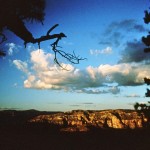

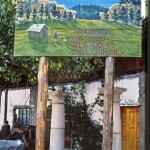
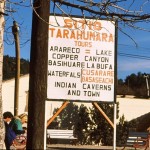
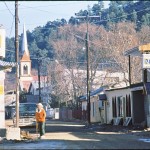
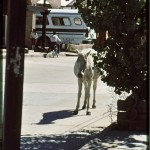
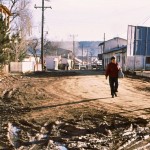
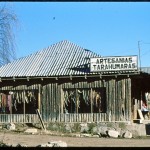
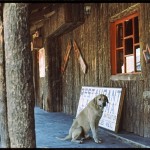

![“...the ticket agent will probably assume, if you are a gringo, that you want to travel 1st class. [and] You probably do...”](https://mjohnfayhee.com/wp-content/uploads/2012/02/cc-creel-waiting-for-train-150x150.jpg)
